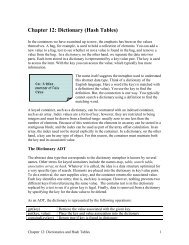Worksheet 11: Recursive Functions and Recurrence ... - Classes
Worksheet 11: Recursive Functions and Recurrence ... - Classes
Worksheet 11: Recursive Functions and Recurrence ... - Classes
Create successful ePaper yourself
Turn your PDF publications into a flip-book with our unique Google optimized e-Paper software.
<strong>Worksheet</strong> <strong>11</strong>: <strong>Recursive</strong> <strong>Functions</strong> <strong>and</strong> <strong>Recurrence</strong> Relations Name:<br />
<strong>Worksheet</strong> <strong>11</strong>: <strong>Recursive</strong> <strong>Functions</strong> <strong>and</strong> <strong>Recurrence</strong><br />
Relations<br />
In Preparation: Read the section on recursive functions <strong>and</strong> recurrence relations in<br />
Chapter 4.<br />
void printBinary (int v) {<br />
if ((v == 0) || (v == 1))<br />
print(n);<br />
else {<br />
printBinary(v/2);<br />
print(v%2);<br />
}<br />
}<br />
number, we have the following equation:<br />
As described in Chapter 4, a very useful technique for<br />
analyzing recursive functions is to form recurrence<br />
relations. For example, suppose we are analyzing the<br />
function shown at left. Let n will represent the number<br />
of binary digits in the printed form. Because the<br />
argument is divided by 2 prior to the recursive call, it<br />
will have one fewer digit. Everything else, outside of the<br />
recursive call, can be performed in constant time. The<br />
base case can also be performed in constant time. If we<br />
let T(n) represent the time necessary to print an n-digit<br />
T(n) = T(n-1) + c<br />
T(1) = c<br />
Read this as asserting that the time for n is equal to the time for n-1 plus some unknown<br />
constant value. This is termed a recurrence relation.<br />
T(n) = T(n-1) + c<br />
O(n)<br />
T(n) = T(n/2) + c O(log n)<br />
T(n) = 2 * T(n/2) + c a n + c b O(n log n)<br />
T(n) = 2 * T(n-1) + c O(2 n )<br />
The four most common recurrence<br />
relations <strong>and</strong> their solutions are shown at<br />
left.<br />
The following are some example recursive functions. Describe the running time for each<br />
as a recurrence relation, <strong>and</strong> then give the big-Oh execution time:<br />
factorial(int n) {<br />
if (n = 0) return 1;<br />
else return n * factorial(n-1)<br />
}<br />
double exp (double a, int n) {<br />
if (n == 0) return 1.0:<br />
else return a * exp (a, n-1);<br />
}<br />
void Hanoi (int n, int a, int b, int c) {<br />
if (n > 0) {<br />
An Active Learning Approach to Data Structures using C 1
<strong>Worksheet</strong> <strong>11</strong>: <strong>Recursive</strong> <strong>Functions</strong> <strong>and</strong> <strong>Recurrence</strong> Relations Name:<br />
Hanoi(n-1, a, c, b);<br />
System.out.println(“Move from “ + a + “ to “ + b + “using “ + c);<br />
Hanoi(n-1, c, b, a);<br />
}<br />
}<br />
For the following, let n represent the size of the region of the array between low <strong>and</strong> high<br />
int binarySearch (double data[ ], int low, int high, double test) {<br />
if (low == high) return low;<br />
int mid = (low + high)/2;<br />
if (test < data[mid]) return binarySearch(data, low, mid, test)<br />
else return binarySearch(data, mid, high, test);<br />
}<br />
An Active Learning Approach to Data Structures using C 2

















